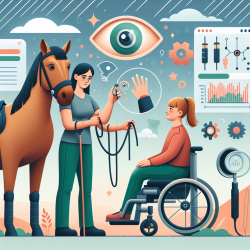Introduction
In the realm of speech-language pathology, understanding the long-term cognitive and behavioral impacts of stroke is crucial for developing effective treatment plans. A recent study titled "Latent disconnectome prediction of long-term cognitive-behavioural symptoms in stroke" offers groundbreaking insights into predicting these outcomes using advanced neuroimaging techniques. This blog will delve into the implications of this research for practitioners, highlighting how it can enhance therapeutic strategies and encourage further exploration in the field.
The Disconnectome Framework
The study introduces a novel framework known as the Disconnectome Symptoms Discoverer (DSD), which leverages a comprehensive atlas of disconnectome-deficit relationships. This framework utilizes acute clinical neuroimaging data to predict neuropsychological scores one year post-stroke. The predictive model achieved a mean absolute error below 20%, outperforming six other models, including those based on functional disconnection and lesion topology.
Implications for Practitioners
For practitioners, the disconnectome framework offers a data-driven approach to anticipate long-term cognitive and behavioral symptoms in stroke patients. By understanding the specific brain disconnections associated with various neuropsychological outcomes, therapists can tailor interventions more effectively. This personalized approach can lead to improved recovery trajectories and better quality of life for patients.
- Enhanced Predictive Accuracy: The DSD framework's ability to predict outcomes with high accuracy allows practitioners to set realistic goals and expectations for recovery.
- Personalized Treatment Plans: By identifying specific disconnectome patterns, therapists can design interventions that target the unique needs of each patient.
- Resource Optimization: Accurate predictions can help allocate therapeutic resources more efficiently, ensuring that patients receive the most appropriate care.
Encouraging Further Research
While the disconnectome framework represents a significant advancement, it also opens the door for further research. Practitioners are encouraged to explore the following areas:
- Integration with Other Modalities: Combining disconnectome data with other neuroimaging techniques could enhance predictive accuracy and provide a more comprehensive understanding of stroke recovery.
- Longitudinal Studies: Investigating how disconnectome patterns evolve over time can offer insights into the dynamics of brain recovery and inform long-term therapeutic strategies.
- Cross-Population Validation: Applying the framework across diverse populations can help validate its generalizability and identify potential cultural or demographic variations in stroke outcomes.
Conclusion
The latent disconnectome prediction framework offers a promising avenue for enhancing therapeutic outcomes in stroke patients. By leveraging this innovative approach, practitioners can improve their predictive capabilities and tailor interventions to meet the specific needs of their patients. As we continue to explore the intricacies of brain connectivity and its impact on recovery, the potential for personalized medicine in speech-language pathology grows ever closer.
To read the original research paper, please follow this link: Latent disconnectome prediction of long-term cognitive-behavioural symptoms in stroke.










